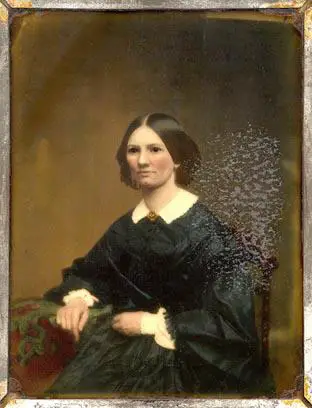|
Origins
John
Jabez Edwin Mayall was born in 1813, near Oldham in Lancashire,
England. J.J.E.Mayall is often referred to as an American photographer,
but this is an error. Some modern reference works on early photography
state that he had his origins in America and that he was a native
of Pennsylvania. This is perhaps not surprising, as many of
Mayall's contemporaries, including Queen Victoria, mistook him
for an American and he initially made his name as a daguerreotypist
in Philadelphia.
The photographer who became known as John Jabez Edwin Mayall,
was the son of John and Elizabeth Meal and his birth was registered
under the name Jabez Meal in Manchester, in the county
of Lancashire, on 17th September 1813. Mayall's father was described
as a manufacturing chemist and is believed to have specialized
in the production of dyes for the linen industry. Jabez Meal
(J.J.E. Mayall) was born in the Oldham area of Lancashire,
but by 1817 John Meal and his family were living at Lingards,
near Huddersfield in the cloth manuacturing region of West Yorkshire.
In Baine's Directory of 1822, Mayall's father, John Meal, is
listed as a dyer in Linthwaite.
or(RIGHT)
Portrait of John J E Mayall [ c1845] .
This portrait of John
J E Mayall was made in Philadelphia ,where Mayall established
a daguerreotype portrait studio in the 1840s. His early career
as a daguerreotypist in Philadelphia led to the mistaken belief
that the Lancashire-born Mayall was an American.o
dio
|
1 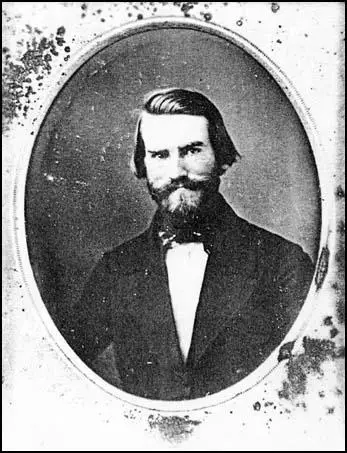 |
Early Career in West Yorkshire ( 1833-1842 )
Books on local history which deal with the Linthwaite and Slaithwaite
district report that in his twenties Jabez Meal (J.J.E.Mayall)
worked in the linen thread trade of West Yorkshire. Canon Charles
A. Hulbert, formerly a vicar at the church of Slaithwaite, near where
Jabez Meal (J.J.E.Mayall) lived as a young man, recalls Jabez in a
memoir :
"Mr Jabez E. Mayall, of Linthwaite, was one of the most eminent
natives of the village. He carried on Dye Works and studied Chemistry
and other sciences in general."
Canon Hulbert could have confused Jabez with his father John Meal,
who was a chemist and dyer, or perhaps young Jabez had taken over
the running of his father's dye works. John Sugden in "Slaithwaite
Notes of the Past and Present" (1905) adds the intriguing detail
that while in West Yorkshire, Jabez (J.J.E.Mayall) built up a large
fortune, and lost it "through no fault of his own, neither
by dishonour, disgrace or neglect of duty." It is not clear
whether Sugden was alluding to the financial collapse of the Meal's
dye works or the failure of Jabez's next venture as a proprietor of
an inn on the Manchester Road.
In 1834, Jabez Meal (J.J.E.Mayall) married Eliza Parkin,
the 18 year old daughter of Joseph Parkin, landlord of the Star Inn
on the Manchester Road, near Linthwaite, West Yorkshire. After the
death of his father-in-law, Jabez (J.J.E.Mayall) took over the 'Star
Inn' where "he taught a number of his more promising customers
the three Rs, English and Latin."
Jabez and Eliza's first son Edwin was born in 1835. A second
son, born in 1839, was named Joe Parkin after Mayall's father-in-law.
The loss of a large fortune could explain Jabez's change of circumstances
as recorded in the 1841 census return.
|
1841
Census: Lingards, near Huddersfield, Yorkshire
Jabez Meal, Flax Spinner, age 25 (rounded down from 28 years)
- born outside Yorkshire.
Eliza Meal, wife, age 25 - born in Yorkshire
Joe Meal, son, age 1 - born in Yorkshire
[Jabez's eldest child, Edwin Meal, then aged 6, was not at home
at the time of the 1841 Census]
|
A third son, John, was born on 7th January 1842. The birth
was registered in Slaithwaite, Yorkshire. Around this time, Jabez
Meal (J.J.E. Mayall) decided to travel to North America. According
to Canon Hulbert of Almondbury in Yorkshire, the 28 year old was an
intelligent young man who had ambitions beyond the linen trade :
"Slaithwaite was scarcely a sufficient sphere for his genius
and he emigrated to the United States, where he took
up the then infant Art of Photography; which he much improved by his
experiments and discoveries."
J.J.E.Mayall may have experimented with photography before
he set off for Philadelphia in 1842. In an interview with the editor
of the Photographic News, Mayall stated that his "first handling
a Daguerreotype was on 6th January 1840", two years before
he embarked for America.( In later English advertisements, Mayall
claimed he had been a photographer since 1840 ).Richard Beard's patent
restrictions on the commercial use of the daguerreotype process in
making portraits, together with the advances already made in the science
and art of the daguerreotype in the United States, possibly persuaded
Mayall to develop his photographic talents in Philadelphia.
Mayall
as a Daguerreotypist in Philadelphia ( 1842-1846 )
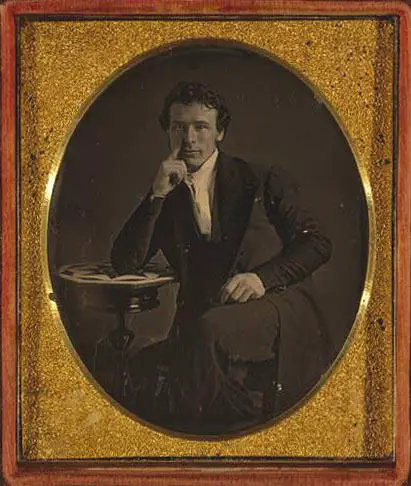
Daguerreotype
self portrait by John Jabez Edwin Mayall made in Philadelphia around
1842.
Around 1842, Jabez Meal travelled to Philadelphia in the United
States. It was in America that Jabez Meal became known as John
Jabez Edwin Mayall.
Soon after his arrival in Philadelphia, Mayall made contact with Dr
Paul Beck Goddard (1811-1866) a physician and chemist at the University
of Pennsylvania. Dr Goddard had been one of the first scientists in
Philadelphia to become interested in the daguerreotype process and
in December 1839, he had perfected the use of bromine to shorten the
length of time required to expose a sensitized daguerreotype plate.
By accelerating daguerreytype exposure times, Goddard had made it
possible to make a portrait in seconds rather than minutes. Dr Goddard
became a technical adviser to Robert Cornelius (1809-1893),
who had made a daguerreotype self portrait as early as November 1839.
Around May 1840, Dr Goddard had become a silent partner in Robert
Cornelius's daguerreotype portrait studio in Philadelphia, which remained
in business until 1842.
One of Dr Beck's colleagues at the University of Pennsylvania, Professor
Martin Boye (1812-1907) a Danish chemist, instructed Mayall in
the science of making daguerreotypes.
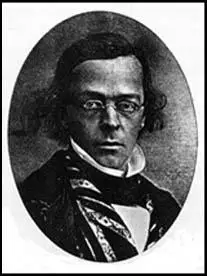
[ABOVE] Dr Paul
Goddard of the University of Pennsylvania. This young physician
gave lessons to Mayall in photo-optics.He also instructed
Mayall in the use of bromine in accelerating exposure times
in the production of daguerreotype portraits.
|
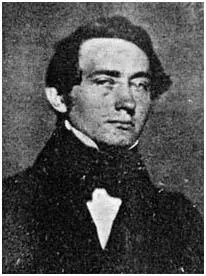
[ABOVE RIGHT]
Portrait of Professor Martin Hans Boye, from a daguerreotype
by Robert Cornelius (1840) . Professor Boye instructed Mayall
in photo-chemistry during his stay in America.
[FAR RIGHT]"
Professor Boye with book in hand and filtering stand on table".Daguerreotype
by Robert Cornelius, dated December 1843.[GEORGE
EASTMAN HOUSE]
Boye lectured on chemistry at the Central High School, Philadelphia
- possibly the origin of Mayall's nickname "Professor High
School."
|
|
From
1843, Mayall produced a large number of daguerreotypes, including
a set of ten pictures illustrating the Lord's Prayer.
Around 1844, Mayall entered into partnership with Samuel Van Loan,
who had previously worked as a daguerreotypist in the English town
of Manchester, only 30 miles from where Mayall was living in 1841.
Richard Beard had established a daguerreotype portrait
gallery at Ducie Place, Manchester on 18th November 1841. Beard had
passed on the Manchester studio to the American daguerreotypist John
Johnson in November 1842 and it is possible that Van Loan travelled
with Johnson when he returned to America in 1844.
|
Mayall's
Daguerreotype Studio in Philadelphia
Mayall and Van Loan established a studio at 140 Chestnut
Street, Philadelphia and they immediately attracted public
attention for the high quality of their daguerreotypes. In October
1844, the partnership of Van Loan & Mayall received
a silver medal for work exhibited at the Franklin Institute.
At the 1845 Exhibition at the Franklin Institute, daguerreotypes
by Van Loan & Mayall were judged "superior and entitled
to Third Premium."
[ RIGHT]
Daguerreotype portrait studio
of J E Mayall at Chestnut and
Fifth Streets, Philadelphia
di
|
1

|
Around
1846, Mayall's partnership with Van Loan came to an end. Philadelphia's
Mercantile Directory of 1846, lists "J.E.Mayall, late Van Loan
& Mayall, Chestnut and Fifth Streets, Philadelphia" in the
section devoted to daguerreotype artists.
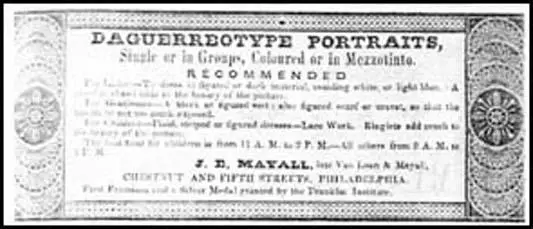
[ABOVE]
An advertisement in Philadelphia's Mercantile Directory of 1846
giving details of the daguerreotype portrait studio of J E Mayall
( late Van Loan & Mayall ) at Chestnut and Fifth Streets, Philadelphia.
John Mayall returned to England later that year.
During his stay in America Mayall gave lectures on the art of photography.
In May 1846, he delivered a "memoir on the daguerreotype"
to the Philosophical Society of the United States, which was meeting
in Philadelphia. Mayall also had links with Philadelphia's Central
High School, where his mentor, Professor Martin Boye held the Chair
of Chemistry. (On his return to England, Mayall adopted the nickname
'Professor High School').
On 20th June 1846, Mayall sold his Chestnut Street studio to Marcus
Aurelius Root, a teacher of writing residing in the same building.
Marcus A Root (1808-1888) was later to become an internationally successful
daguerreotypist and the author of an important book on photography
entitled "The Camera and the Pencil". After selling
his daguerreotype portrait studio in Philadelphia, J.J.E.Mayall set
sail for England.
Mayall's
Career as a Daguerreotype Artist in London (1846-1860 )
|
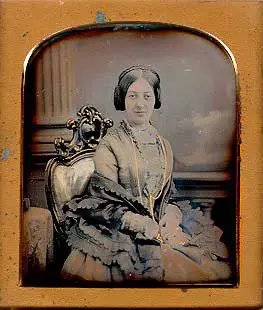
[
LEFT] Daguerreotype portrait of
an unknown woman from the studio of J E Mayall
at 433 West Strand, London.
|
1
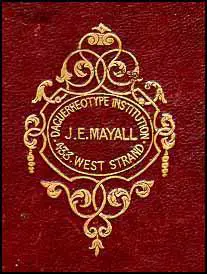
[ABOVE RIGHT]
Trade Plate for J E Mayall's studio at 433 West Strand, London,
from the leather case
of a daguerreotype
portrait.
|
Mayall's
London Studio
On his return to England, Mayall worked for a short time with Antoine
Claudet at his Daguerreotype Portrait Gallery on King William
Street, near the Strand in London. Antoine Claudet (1797-1867) was
Richard Beard's main rival in London in 1846.
By April 1847, John J E Mayall had established his own 'Daguerreotype
Institution' at 433 West Strand, London. Cornelius Jabez
Hughes (1819-1884), who was later to become a photographer to
the Royal Family on the Isle of Wight, was employed as Mayall's secretary
and chief assistant.
Hughes placed an advertisement for Mayall's Daguerreotype Institution
in 'The Times' newspaper on 18th May 1847. In the advertisement
Mayall was presented as "Professor Highschool - late of
Philadelphia, U.S." As mentioned earlier, Mayall had been associated
with Philadelphia's Central High School during his stay in America
and probably adopted the title of Professor to reflect his scientific
training as a chemist and to reinforce his claims to be a pioneering
inventor in the field of photography.
Mayall
was never one to make modest claims about his contribution to the
art and science of photography. Under the heading 'NEW DISCOVERIES
IN DAGUERREOTYPE' the notice in 'The Times' reads "In
consequence of the new discoveries which he has made . . . he is enabled
to take daguerreotype portraits by an entirely new process, of a degree
of delicacy, depth of tone, and lifelike reality, never previously
attained by himself of any other photographic artists." The
advertisement of May 1847 went on to add that the gallery of the Institution,
contained "the finest collection of daguerreotype pictures
ever exhibited." Many of Mayall's pictures exhibited in the
Institution's gallery were daguerreotypes he had made in America,
including "panoramas of the Falls of Niagara" and "fine
art illustrations of the Lord's Prayer", which had been made
four years earlier in Pennsylvania.
Mayall
and 'High Art' Photography
In
the late 1840s, Mayall was keen to stress the artistic qualities of
his daguerreotypes and stake his claim as an artist rather than a
straightforward commercial portrait photographer. Looking back to
the year 1847, Mayall recalled that at this point of his career "I
was a struggling artist, much devoted to improving my art."
( NOTE ; In census returns, John J.E.Mayall
always gives his profession as "Artist.")
Right
at the beginning of his photographic career in 1843, while studying
under Professor Boye in Philadelphia, Mayall had planned a series
of ten daguerreotypes, which would illustrate the Lord's Prayer.
In 1845, before his return to England, Mayall was regarded as a pioneer
in the production of allegorical photographs. Two years later in his
studio on the Strand in London, Mayall was producing artistic daguerreotypes
with titles such as "This Mortal must put on Immortality."
In April 1847, Maylal wrote two articles in the 'Athenaeum'
journal in which he outlined his ideas on the use of colouring and
'chiaroscuro' (light and shade) in daguerreotype pictures.
From
1847 Mayall concentrated on producing "daguerreotype pictures
to illustrate poetry and sentiment", which he was later to
show at the Great Exhibition of 1851. For example, in 1848, Mayall
made six daguerreotype plates which visualized the story related in
Thomas Campbell's poem "The Soldier's Dream".
Mayall
and J. M. W. Turner
Soon after establishing his studio in the Strand, Mayall came to know
the English artist J.M.W.Turner (1775-1851). Turner visited
Mayall's premises regularly from 1847 to 1849, yet only at the end
of their acquaintance did Mayall realise that the elderly man who
took an interest in his work was the great landscape painter.
Turner was fascinated by the light effects captured by Mayall's camera
and he showed particular interest in his daguerreotypes of the Niagara
Falls.
"He wished me to copy my views of Niagara - then a novelty
in London - and inquired of me about the effect of the rainbow spanning
the great falls."
Mayall also recalled that he and Turner exchanged "ideas about
the treatment of light and shadow."
Mayall mentions that he took "several admirable daguerreotype
portraits" of Turner. From Mayall's account it appears that
some of these portraits were not straightforward likenesses, but attempts
to create Rembrandt-like figure studies:
"At first he was very desirious of trying curious effects
of light let in on the figure from a high position, and he himself
sat for the studies." Mayall admits that he doctored the
daguerreotype plates to achieve the desired results, commenting that
"some I rubbed out where we tried the effect of a sharp, narrow
cross light, in which some parts of the face were left in strong shadow."
|
J
M W Turner and Mayall's Daguerreotypes
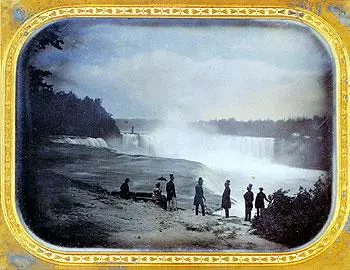
[
ABOVE] Daguerreotype of Niagara Falls, similar to the
views of Niagara admired by J M W Turner in Mayall's London
studio.The famous landscape artist was fascinated by the light
effects captured by the daguerreotype camera.
di
|
1

[
ABOVE ] Portrait of J M W Turner from
a daguerreotype by J E Mayall.(1849)
This is a copy
of a painted engraving by Daniel J Pound based on Mayall's
original daguerreotype.
|
Mayall
was keen to stress the artistic qualities of his daguerreotypes. In
April 1847, 'The Athenaeum' had published an article on Fine
Art Daguerreotype Studios and favourably compared Professor Highschool's
artistic daguerreotypes with the work of William Edward Kilburn
(1819-1891) who had also opened a studio in London that year and
was gaining a reputation for his coloured daguerreotype portraits
which aspired to the art of miniature painting.
It
appears that in these early years, Mayall was finding it hard to make
his way as a daguerreotypist in London. Mayall commented that at this
point in his career "I was a struggling artist, much devoted
to improving my art." In correspondence with G.Walter Thornbury,
Turner's biographer, Mayall recalled that the old artist offered encouragement
when he was losing heart :
"When somewhat desponding on my success one day, I told him
London was too large for a man with slender means to get along. He
sharply turned round and said, "No, no; you are sure to succeed;
only wait. You are a young man yet."
It seems that Mayall was worried about the financial cost of possible
legal action from Richard Beard, the patentee of the daguerreotype
process in England. Mayall told Thornbury, "I was at that
time fighting the battle of the patent rights of the daguerreotype."
This struggle with Richard Beard is alluded to by William Constable,
the daguerreotype licensee in Brighton, who referred to Beard's conflict
with a "photographer from Philadelphia."
Richard
Beard, who had purchased the patent rights for the daguerreotype process
in 1841, took legal action against a number of professional photographers
who were making daguerreotype portraits without a licence. It seems
that Mayall, who had previously worked unfettered as a daguerreotype
artist in America and as an operator for Claudet in London, was not
prepared to purchase a licence from Beard.When Mayall faced financial
difficulties as a result of Beard's threatened legal action, J.W.M.Turner
generously made a loan of £300 to his new photographer friend.
Mayall later revealed that the money was offered by Turner "on
the understanding that he was to repay him if he could."
By August 1848, Mayall had dropped the pseudonym "Professor Highschool"
and advertisements began to introduce him as "Mr.Mayall of Philadelphia,
United States." Mayall now called his studio and gallery the
"American Daguerreotype Institution". Mayall
must have been aware that American Daguerreotypes were generally considered
to be superior to those produced by English studios.
Walter
Thornbury mentions that Mayall, in his early days as a daguerreotype
artist in London, was
making illustrative daguerreotypes to "tell a story".
Turner's biographer describes one pair of
daguerreotypes, shown by Mayall in 1847, which picture the "before"
and "after" scenes associated
with the collapse of stock market shares during the Railway Mania
of the 1840s. Mayall must have
been one of the first daguerreotypists in England to make photographs
for a satirical purpose.
At the end of March 1849, Mayall exhibited at the Royal Institution
what he claimed were "the largest daguerreotype portraits
ever taken in England". In the 1840s, the largest size of
daguerreotype was the 'whole plate' measuring 61/2
by 81/2 inches (16.5cm X 21.6cm.) Mayall's
mammoth daguerreotypes were reported to be two or three times the
size of the conventional 'whole plate'. Other daguerreotypists claimed
to have produced enormous daguerreothype portraits, but Mayall was
quick to dispute his rivals' claims. In an advertisement headed "THE
LARGEST DAGUERREOTYPE PORTRAITS" dated 12th April 1849
Mayall adds the note "As no other pictures have been taken
in any degree approaching these in size, all recent advertised pretensions
can only be intended to mislead the public."
Mayall and the Great Exhibition of 1851
In May 1851, The Great Exhibition of the Art and Industry of All Nations
opened at the Crystal Palace in Hyde Park London. During the six months
it remained open, over six million people visited the Great Exhibition.
Mayall produced a series of mammoth plates of the Crystal Palace and
the exhibition. Thirty-one of Mayall's daguerreotype views of the
Great Exhibition were copied and engraved to proved over a third of
the illustrations published in John Tallis & Co's "History
and Description of the Crystal Palace and the Exhibition of the World's
Industry."
8
|
[ BELOW
] Daguerreotype of the Interior
of the Crystal Palace at
the time of the Great Exhibition
byiJohn J E Mayall (1851)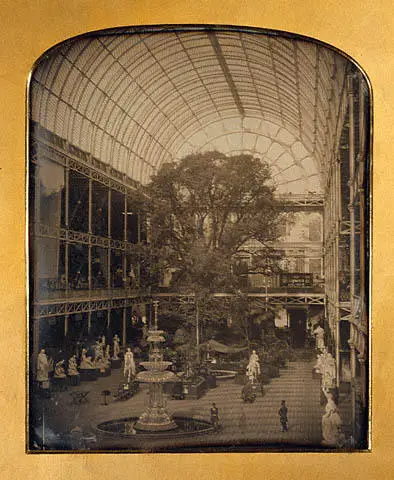
|
|
A section of the Great Exhibition was devoted to Daguerreotypes and
Calotypes. Six nations - the United States, England, France, Italy,
Germany and Austria - exhibited a total of 700 pictures in what is
regarded as the first international photography competition, Mayall
exhibited 72 daguerreotypes in the photographic section and he received
an Honourable Mention in the jury's official report on the photographic
exhibits. Three of the five medals awarded to daguerreotypes went
to the Americans Matthew Brady, Martin M Lawrence and
John A Whipple. The official report reads: "On examining
the daguerreotypes contributed by the United States, every observer
must be struck by their beauty of execution, the broad and well toned
masses of light and shade, and the total absence of all glare, which
render them so superior to many works of this class." The
jury's report declared that the American daguerreotypes "present
a faithful transcript of the subject and yield to none in excellence
of execution." Another report commented, "The United
States department is of a very superior character . . . in the
general tone of the pictures there will be found an artistic excellence
wich we do not meet with in many others." The Illustrated
London News of 17th May 1851 recognized the superiority of the
American daguerreotypes exhibited : "After a very minute and
careful examination we are inclined to give America the first place"
and judged the quality of the American daguerreotypes as "super-excellent."
Horace Greeley, editor of the New York Tribune, wrote from London:
"In Daguerreotypes it seems to be conceded that we beat the
world where excellence and cheapness is both considered - at all events,
England is no where in comparison".
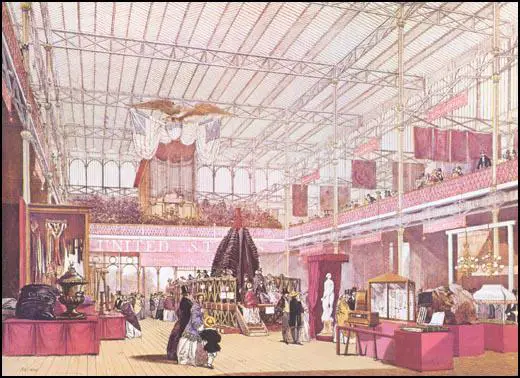
American Section at the Great Exhibition of 1851.Coloured
lithograph by the Dickinson Brothers
The
Illustrated London News review of the daguerreotype exhibits
at the Great Exhibition singled out Antoine Claudet and John
Mayall in the English section of the exhibition :
"Whilst stating that the Americans have surpassed all nations
in the production of Daguerreotypes, it must not be understood that
the English are much deficient in this brand of art. Mons.Claudet
has exhibited a very fine collection. Mr Mayall, who, perhaps must
be regarded as an American, has also a good display." Mayall
received an "Honourable Mention" for the daguerreotypes
he exhibited at the Crystal Palace and looking back over Mayall's
career nearly thirty years later the "Photographic News"
stated that the pictures he showed at the Great Exhibition "brought
him to the front rank."
Portraits
of Eminent Men
In 1852, Mayall advertised a second establishment in London, situated
at 224 Regent Street on the corner of Argyll Place, which Mayall
claimed had "the finest situation for light in London."
In an advertisement published in the 'Hastings & St Leonards'
News' on 21st May, 1852, visitors to London were invited to inspect
"Mr Mayall's extensive collection of Portraits of Eminent
Men" at both of Mayall's Daguerreotype Institutions.
|
1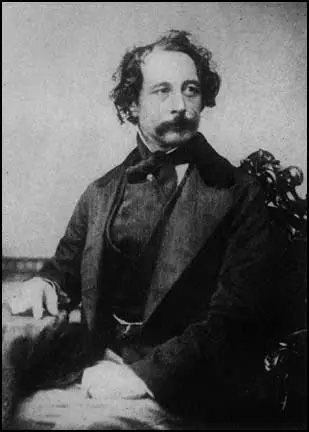
Charles
Dickens
|
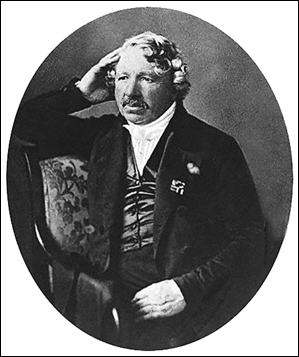
Louis
Jacques Mande Daguerre
|
Mayall
the Innovator
Early
in his career as a daguerreotype artist, Mayall regarded himself as
a pioneer and inventor, introducing new techniques and novelties in
the art of photography. For example, in 1846, during his stay in Philadelphia,
Mayall had proposed employing a weak solution of ammonia to improve
the appearance of daguerreotypes and shorten exposure times to about
9 seconds. Mayall had also championed the use of 'lamp black', a pigment
derived from soot, as an agent for buffing daguerreotype plates. His
adoption of novelties often brought him into conflict with other practitioners.
Apparently, while in America, Mayall was using a method of hand-colouring
daguerreotypes that had been patented in England by Richard Beard
four years earlier in 1842. Frederick and William Langenheim,
who operated a daguerreotype studio in Philadelphia, took legal
steps in 1846 to prevent Mayall from using his colouring process as
they believed they held the American rights for colouring daguerreotypes.
Similarly, after he returned to England and set up his own daguerreotype
studio in 1847 on the Strand in London, Mayall clashed with Richard
Beard, who believed the interloper from Philadelphia was infringing
his patent rights on the daguerreotype process. In May 1847, under
the heading "New Discoveries in Daguerreotype", Mayall,
in the guise of 'Professor Highschool', placed an advertisement
in "The Times" alleging that he was taking daguerreotype
portraits by "an entirely new process," implying
that his method of making daguerreotypes was distinct from the method
patented by Beard.
Giant
Daguerreotypes and Microscopic Portraits
In
March 1849, J.J.E. Mayall exhibited what he asserted were "the
largest daguerreotype portraits ever taken in 'England". During
this period, there were rival claims by other photographers that they
had also made giant daguerreotypes. Mayall quickly placed an advertisement
in 'The Times' re-iterating his declaration that he had produced
"the largest daguerreotype portraits" and added drily,
"As no other pictures have been taken in any degree approaching
these in size, all recent advertised pretensions can only be intended
to mislead the public."
In
'The Times' newspaper of 1st July 1850, Mayall claimed that
he could "take portraits from 30 inches in length down to
the microscopic size." (The Science Museum of London possesses
a large daguerreotype portrait from this period which measures 29
inches by 25 inches - approximately 73.5 cm x 63.6 cm)
Mayall
applied his skills in microphotography to produce very small portraits
which could be set in jewellery. A memorial ring in gold and black
enamel, containing a microphotograph of Albert, the Prince Consort,
believed to have been taken by Mayall in 1861, is held today in the
Royal Family's Photograph Collection.
Hand-Coloured
Daguerreotypes
In
the 1840s, the daguerreotype portrait had virtually supplanted the
hand-painted portrait miniature. Some critics complained that the
daguerreotype portrait on a metal plate was cold and harsh and lacked
the finesse and charm of the small-scale painted portrait. In March
1842, Richard Beard had patented a method of colouring daguerreotype
pictures. The following month a newspaper reported that "Mr
Beard has now discovered the means of colouring the plates after the
photographic drawing is completed, thus giving the warmth and truth
of a miniature painting." It is known that Mayall used a
similar method of hand-colouring daguerreotype portraits while based
in Philadelphia. When two journalists visited Mayall's new premises
in London's Regent Street in 1853, they observed the work of the "colouring
room" in which "two damsels were busily at work" adding
colour to Mayall's daguerreotype portraits.
"The colours used by them
were all dry minerals, and were laid on with the fine point of a dry
brush; pointed between the lips; and left to become dry before using.
A little rubbing caused these tints to adhere to the minute pores
upon the plate. Each colour was of course rubbed on with its own brush,
and so expertly, that a large plate very elaborately painted, with
a great deal of unquestionable taste, had been, as we were told, the
work only of an hour."
'Photography' by William Henry
Wills and Henry Morley in 'Household Words' (19th March 1853)
Wills and Morley, the two
journalists, were amused by the fact that the daguerreotype painters
were using colours stored in small boxes. which carried labels such
as "Sky" and "Flesh."
"We pointed to a small
box labelled "Sky", remarking that the fair painters were
magicians, to carry the sky in a wafer box. To which one of them promptly
answered "Yes, and Ogres, too, for that pill-box contains gentlemen's
and ladies' 'Flesh'"
|
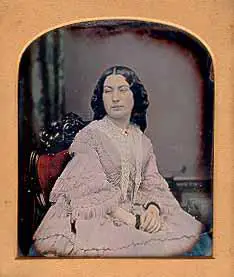
[ABOVE AND RIGHT
] Hand coloured daguerreotype portraits
from Mahall's London studios.

[ABOVE AND RIGHT ]
Mayall's trade plates from the leather cases cntaining daguerreotype
portraits taken at Mayall's London studios.
[
|
1
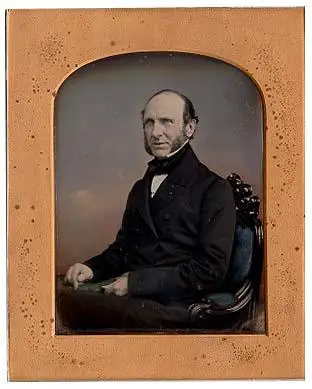
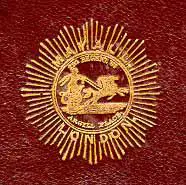
|
Photographic
Miniatures
In
the 1850s, Richard Beard was advertising his "Photographic
and Daguerreotype Miniatures", informing the public that his
daguerreotypes were remarkable "for breadth of effect and
beauty of colour, and the Photographs on Paper (finished as paintings
in watercolours or crayons) are equal to the best Miniatures, with
this advantage, that the likenesses are marvellously accurate."
Daguerreotype
portraits could be tinted with dry colour, but photographs on paper,
such as the Talbotype and prints from the collodion process
lent themselves more easily to traditional painting in watercolour.
Established miniaturists who were losing out to the new invention
of photography found "renewed occupation in colouring photographs."
Samuel
Robert Lock (1822-1881),who was to later enter into partnership
with George C Whitfield to form the photographic firm of Lock
and Whitfield and set up a branch studio in Brighton's Kings Road,
was a fashionable miniature painter. In the early 1850s, Lock was
employed by Nicholas Henneman to colour Talbotype portraits
and convert them into "beautiful miniatures."
Photographs
on Ivory
A
number of miniaturists painted their portraits directly over photographic
likenesses taken on paper, These miniature photo-paintings had a passing
resemblance to traditional portrait miniatures, but, to cover the
evidence of the mechanical aid, the painting was often heavy handed
and lacked the delicacy and subtlety of a genuine portrait miniature.
The
earliest portrait miniatures had been painted in gouache or body colour
on vellum stretched over card. From the middle of the 18th Century
it became fashionable to paint miniature portraits in transparent
watercolour on ivory. Because ivory was very valuable, miniature portraits
painted directly on to ivory were associated with high status and
exclusivity.
After
the introduction of Archer's collodion process a number of
photographers experimented with materials other than glass to use
as a base for collodion positives. Around 1853 Adolphe Alexandre
Martin (1824-1896) a French teacher, put forward the idea of using
thin sheets of enamelled iron and in 1854 a Liverpool photographer
suggested photographs on dark-coloured leather. In the early 1850s,
Mayall worked on producing a substance that resembled ivory and could
hold photographic images on its surface. He clearly hoped that he
would eventually be able to produce photographs that closely resembled
the portrait miniature on ivory. In October 1855, Mayall filed a patent
for his "Artificial Ivory for receiving photographic pictures."
(British Patent No 2381)A
mixture of powdered bone or ivory and albumen was worked into a palste
and combined with gelatine. The 'artificial ivory' mixture was rolled
out in thin slabs and specially prepared to received photographic
images.In
the late 1850s, a number of portrait miniaturists were painting over
photographs imprinted on 'ivory' and presenting them as traditional
portrait miniatures.
